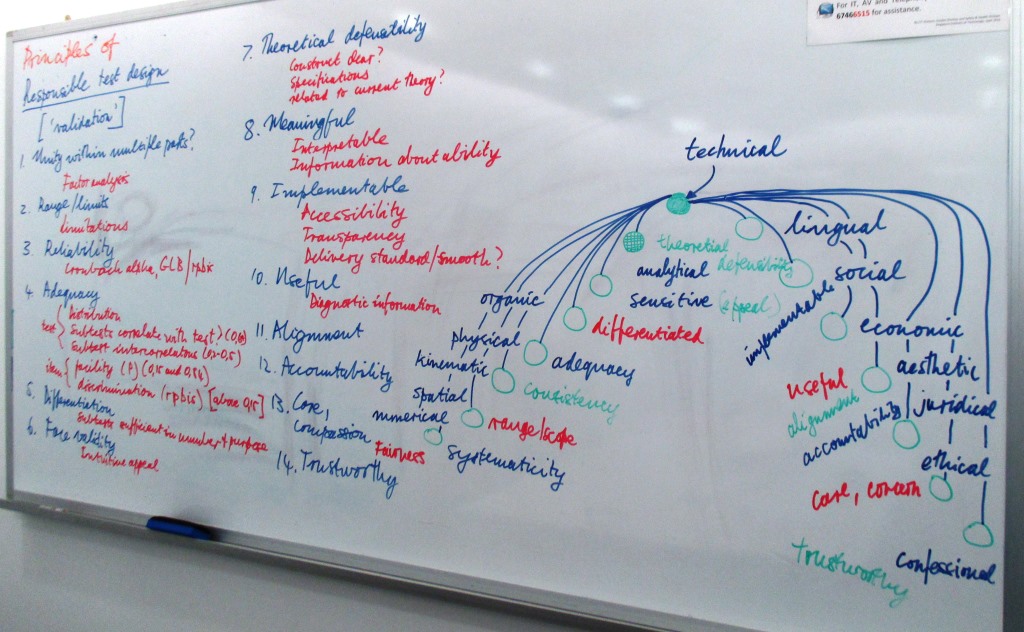 Responsible design of language plans, courses or tests starts with the employment of one’s technical imagination, while allowing the design to be guided by the following principles:
Responsible design of language plans, courses or tests starts with the employment of one’s technical imagination, while allowing the design to be guided by the following principles:
- Systematicity. Systematically integrate multiple sets of evidence in arguing for the validity of the language plan, language test or language course design.
- Scope. Specify clearly to the users of the design, and where possible to the public, the appropriately limited scope of the language policy, the assessment instrument or the intervention, and exercise humility in doing so. Avoid overestimating, or making inappropriate claims about what the solution proposed can in fact accomplish.
- Reliability. Ensure that the policies set out, the measurements obtained or the instructional opportunities envisaged are consistent, and obtain, if possible, empirical evidence for the reliability of the solution designed.
- Adequacy. Ensure effective language strategy, measurement or instruction by using defensibly adequate policies, instruments or material.
- Differentiation. Have an appropriately and adequately differentiated plan, course or test.
- Appeal. Make the plan, course or test intuitively appealing and acceptable.
- Defensibility. Mount a theoretical defence of what is adopted as policy, or what is taught and tested, in the most current terms, or at least in terms of clearly articulated alternative theoretical paradigms or perspectives.
- Meaningfulness. Make sure that the policy is well-articulated, and intelligible; that the test yields interpretable and meaningful results; or that the course is intelligible and clear in all respects.
- Accessibility. To ensure transparency, make accessible to all who will be affected, not only the plan, course or test, but also additional information about these, through as many and diverse media as are appropriate and feasible.
- Utility. Ensure utility; make the policy an efficient measure, or present the course and obtain the test results efficiently and ensure that all are useful.
- Alignment of policy, instruction, and testing. Bring the policy into harmony with the test or language development that it prescribes; mutually align the test with the instruction that will either follow or precede it, and both policy, test and instruction as closely as possible with the learning or language development foreseen in their design.
- Accountability. Be prepared to give account to the users as well as to the public of how policy has been arrived at, the test has been or will be used, or what the course is likely to accomplish.
- Fairness. Value the integrity of the policy, test or course; make no compromises of quality that will undermine their status as instruments that are fair to everyone, and that have been designed with care and love, with the interests of the end-users in mind.
- Reputability. Spare no effort to make the policy, course or test appropriately trustworthy and reputable.
Of course, these principles work together: one cannot be accountable without having first ensured your design satisfies the condition of transparency. Similarly, fairness is unthinkable without reliability. And there will be a decided lack of utility for the design if it does not bring policy, instruction, learning and assessment into harmony. The principles are therefore interdependent: one can examine the quality of a language intervention design by focussing now on one, then on another, but in the end all need to be brought into play as conditions for responsible design.
Also see: Principles of responsible test design
REFERENCE
Weideman Albert. 2017. Design principles and the future of applied linguistics [Chapter 11]. In: Responsible design in applied linguistics: theory and practice. Springer, Cham, pp. 211-231. DOI: https://doi.org/10.1007/978-3-319-41731-8_11

This is a thoughtful and stimulating analysis, which highlights the importance of adopting a nuanced approach that is anchored in a sensitive evaluation of the context in question. Thank you.
LikeLiked by 1 person
Thank you, Mbongeni! And good to hear from you!
LikeLike
Pingback: How to evaluate language interventions: the golden pentagon | Albert Weideman
Pingback: How hot is ‘hot’? How practical can theory be? | Albert Weideman